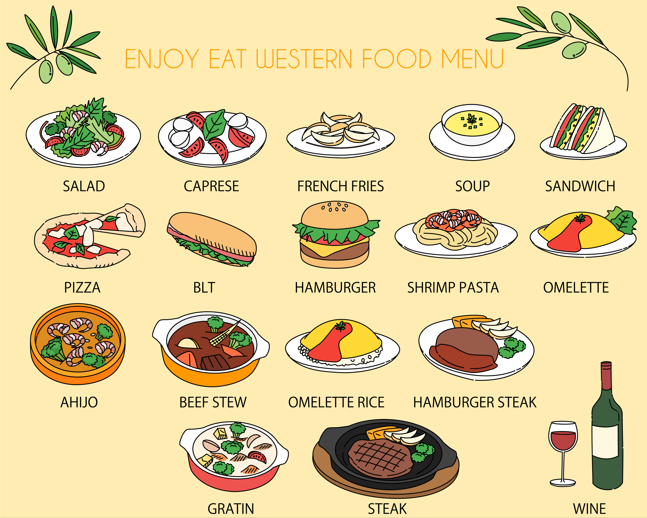Part A Vocabulary
Learn the vocabulary and idioms related to the topic, and describe the picture.

Part A_1 Vocabulary
We’ll read aloud the words and expressions below. Please repeat after me. I will check your pronunciation.
(Please send the mispronounced words and expressions to your student.)
講師の真似をして単語を発音しましょう。
Part A_2 Vocabulary
|
the same
同じもの
|
|
|
so far
ここまで
|
|

|
French fries
フライドポテト
|

|
curious
好奇心の強い
|

|
menu
メニュー
|
|
deceptive
ごまかされる
|


Part A_3 Vocabulary
Now, let’s review some words from part A_2.
(Please review the mispronounced words and expressions from part A_2.)
復習しましょう。
Part A_4 Vocabulary


Part A_5 Picture description
Now, please look at the picture below. Give three actions that you see in the picture.
以下の写真を見てください。3人の人物が何をしているか描写してみましょう。

Part A_6 Picture description

Part A_7 Picture description
| 1. | |
| 2. | |
| 3. |


Part A_8 Picture description
Now, let’s review your answers.
Please review your student’s answers by sending the correct answers in complete sentences. After that, ask your student to read aloud his or her corrected answers.)
復習しましょう。
Part A_9 Picture description

Part B Passage reading
Read sentences and check your pronunciation. Make sure you understand the content.

Part B_1 Passage reading
You will read aloud the passage below. I will check your pronunciation and intonation.
(Please send the mispronounced words and expressions to your student.)
文章を読みましょう。
Part B_2 Passage reading
Wasei-eigo
My host family always has a Japanese-style breakfast – nori, natto, miso soup, and rice. I’m fine with them, but yesterday, my host family took me to a ファミレス (casual restaurant) to give me a chance to enjoy some Western food. They ordered ホットケーキ, フライドポテト, and ブレンド. I was confused but ordered the same. The waiter came back with pancakes, French fries, and coffee. I also noticed some strange and interesting desserts on the menu, like チョコバナナパフェ (chocolate and banana sundae) , ソフトクリーム (soft-serve ice cream), and シュークリーム (cream puff). After breakfast, my host father suggested a Viking dinner. I didn’t understand what Viking meant, but I’m curious.
So far, I have learned lots of these words. My teacher says they’re called wasei-eigo; deceptive words that look like real English but are not in reality. I find them confusing, but it’s not a bad thing. It’s the first step to learning something new.
My advice to you: don’t be surprised if native speakers look confused when you use wasei-eigo.


Part B_3 Passage reading
Now, let’s review some words and sentences from part B_2.
(Please review the mispronounced words and sentences from part B_2.)
復習しましょう。
Part B_4 Passage reading


Part B_5 Comprehension questions
I will ask the following questions. Please answer based on the passage. I will check if your sentences are complete and if the grammar is correct.
講師が以下の質問をします。読んだ内容をもとに答えましょう。

Part B_6 Comprehension questions
| 1. | What is the menu of a typical Japanese-style breakfast? |
Part B_7 Comprehension questions
| Answer: |


Part B_8 Comprehension questions
| 2. | What did they order at the casual restaurant? |
Part B_9 Comprehension questions
| Answer: |


Part B_10 Comprehension questions
| 3. | According to the passage, what are wasei-eigo? |
Part B_11 Comprehension questions
| Answer: |


Part B_12 Comprehension questions
Now, let’s review your answers.
(Please review your student’s answers by sending the correct answers in complete sentences. After that, ask your student to read aloud his or her corrected answers.)
復習しましょう。
Part B_13 Comprehension questions

Part C Fill in the blanks
Fill in the blanks with the correct words/phrases to complete the sentences.

Part C_1 Fill in the blanks
Please choose a word/phrase to complete each sentence. Then, read aloud the sentences.
言葉を選んで文章を完成させましょう。そのあと音読しましょう。
Part C_2 Fill in the blanks

so far
curious
menu
| 1. | I’m ________ to know what happened. I wasn’t at the party yesterday. |
| 2. | Could I see the ________, please? |
| 3. | ________, we haven’t received the package yet. |


Part C_3 Fill in the blanks
Now, let’s review your answers.
(Please review your student’s answers by sending the correct answers in complete sentences. After that, ask your student to read aloud his or her corrected answers.)
復習しましょう。
Part C_4 Fill in the blanks

Part D Q&A
Answer the questions and check your grammar. Make sure you understand the content.

Part D_1 Q&A
Please answer the following questions. I will check if your sentences are complete and if the grammar is correct.
講師が質問しますので答えましょう。


Part D_2 Q&A
| 1. | What Western food do you like the most? |
Part D_3 Q&A
| Answer: |


Part D_4 Q&A
| 2. | What “wasei-eigo” do you usually use? |
Part D_5 Q&A
| Answer: |


Part D_6 Q&A
| 3. | Can you communicate with people without “wasei-eigo”? Why or why not? |
Part D_7 Q&A
| Answer: |


Part D_8 Q&A
| 4. | Do you think there will be more “wasei-eigo” in the future? |
Part D_9 Q&A
| Answer: |


Part D_10 Q&A
Now, let’s review your answers.
(Please review your student’s answers by sending the correct answers in complete sentences. After that, ask your student to read aloud his or her corrected answers.)
復習しましょう。
Part D_11 Q&A

Part E Free talk
Talk about the following topics.

Part E_1 Free talk
Let’s do a free talk about the following topics.
(Please do a free talk if you have time left.)
フリートークをしましょう。

Part E_2 Free talk
| 1. | What do you usually eat for breakfast? Western-style or Japanese-style? |
Part E_3 Free talk
| Answer: |


Part E_4 Free talk
| 2. | Do you like “all-you-can-eat” (バイキング)? If yes, what do you usually eat? If no, why not? |
Part E_5 Free talk
| Answer: |
